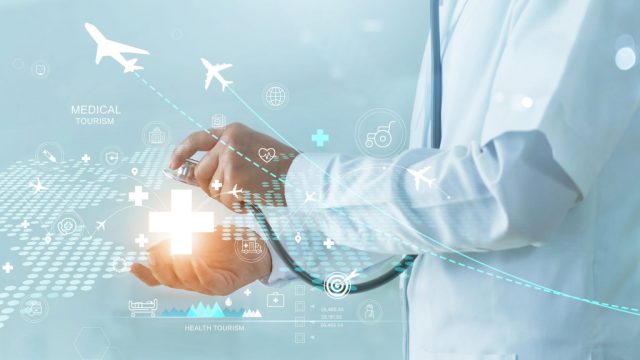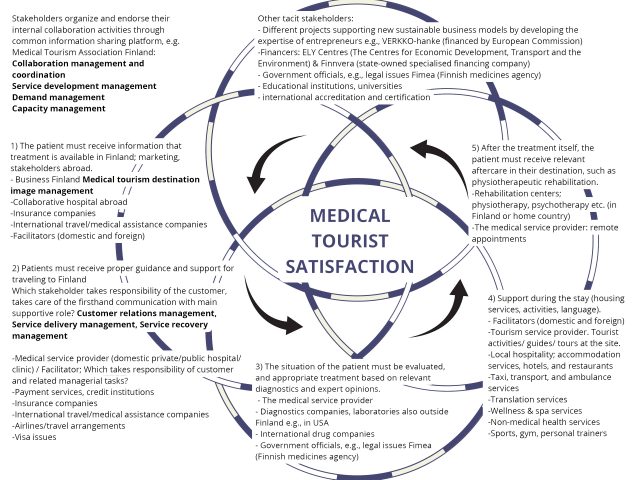Openly collaborative, organized, and functional service process ecosystem paving the way to success in Finnish medical tourism
Keywords: medical tourism, ecosystem, tourism supply chain, tourism service process, service process ecosystem, collaboration in tourism.
Medical tourism- tourism or just a health care intervention abroad?
Medical tourism is originally derived from health tourism that include travelling outside one’s native health care administrative region for the reconstruction or strengthening of personal health by the means of medical interventions and wellness 1. The distinction between the terms health tourism, medical tourism and wellness tourism, are many times misleadingly used synonymously, by specifying that health tourism can be divided to two branches: medical tourism and wellness tourism 2. Still, a medical tourist may include elements from wellness tourism into their experience.

Phenomenon of traveling outside own home country for medical care has been existing long in history and during the last few centuries affluent individuals from less developed regions have travelled to more developed countries to get treatments in more advanced facilities by skilful and well-trained medical staff 3. Although the patient movement across borders is not a new phenomenon, social and economic changes of the recent years have accelerated the transnational demand and supply of health care bringing medical tourism at the crossroad of tourism and medical care activities 4. Along with globalization, the growing numbers of patients and medical professionals travelling across borders, enhancements in health technology, funding and governmental regimes across country borders has brought about unforeseen forms of consumption as well as production of medical services. Seeking medical treatment abroad is preferred by people who attempt to integrate treatment with a touristic holiday with activities and attractions 4,5.
Customer personas- from functionally healthy to terminally ill
Depending on the health status, it is likely that for some medical tourists the holiday and recuperative functions are less topical while for other medical tourists the leisure aspect could have a more important impact on how the medical service purchasing decision is made. Still, the majority of people traveling for medical purposes need at least the basic hospitality services such as accommodation, transportation and restaurant services. Also, accompanying family members may be interested in different services provided by tourism industry.
When a potential medical tourist is searching and selecting providers the most important factors are their personal networks, recommendations from acquaintances, and online search engines. Hence, medical travel incorporates the development towards more individualized health culture with tailor-made service offerings. Therefore, it is important to acknowledge customer motivations and needs in the customer process when developing service processes in medical tourism. The customer, the medical tourist, is in the center focus when these processes and collaboration is planned and aligned.
In general, receiving medical care and being treated at home by carers speaking their own language, being close to relatives, in a system that is recognizable is preferred. Therefore, proximity to home, geographically and/or culturally, is seen as an important factor but there is a willingness, ability, and preparedness to travel longer distances for medical care if it offers some advantages 5, 6. Common factors contributing to seeking medical care abroad are affordable costs, shorter or non-existing waiting times, availability of treatments, i.e. accessibility with issues regarding bioethical legality and insurance coverage, modern medical facilities, equipment and technology, perceived quality of care, including reputation of superior and more advanced skill level of medical personnel and methods, and familiarity, including feeling comfortable with the system, trusting the carers and importantly being able to communicate in own language 3,5,6,7,8,9.
The image of the destination country may have a major impact on the decision-making process. Here Finland has an advantage with its unique set of qualities that can only be found in the Nordic countries. It is emphasized that trustworthiness is a key element, also reflected in transparency in pricing and humane values that are important and prevalent qualities in Finnish medical tourism. Finland should be able to communicate its offering and the good qualities the medical tourism field has to offer compared to global competition.

Glimpse of the Finnish market
Global estimates of the annual amount of people travelling outside their domiciles for medical interventions and the global market evaluation vary; Medical Tourism Association (MTA), a global non-profit organization that advocates on behalf of the industry, has evaluated the number of people to around 14 million with a global market size to USD 4 billion in 2021 10,11. In Finland, treating foreign patients is still small scale and medical tourism as an industry is still in its infancy. Medical tourism growth potential is significant, and Finland as a technologically advanced country, along with long established health technology export, is well prepared to meet growing demand by offering high quality medical services in clean and safe environment 8. A vision set for 2023 by the Medical Tourism Association of Finland is that Finland would be a leading medical tourism destination in the Nordic countries and one of the most popular in Europe with 100 MEUR turnover and 5 MEUR investment 12. In 2022 the total turnover produced by medical tourists in Finnish market was EUR 8,3 million whilst the corresponding annual turnover before the Covid-19 pandemic was ca. EUR 10-15 million and the annual number of medical tourists between the years 2019 and 2022 has been 630 to 380013. There are medical services offered from different medical fields, e.g., oncology, orthopaedics, neurology, and other specialized medical fields such as vascular diseases and obstetrics, as well as rehabilitation and medical check-ups.
Competition in the global market is fierce, which emphasizes the need for more close collaboration among stakeholders, a variety of actors such as hospitals and clinics, medical tourism facilitators, also called patient broker agencies or butler service providers, travel agencies, hotels, airlines, restaurants, and transport companies. At the moment there are only a few companies operating within the medical tourism field in Finland which collaborate with each other, and most are organized in an association. Medical tourism as an industry in Finland is in a phase of a new beginning where the focal actors, the medical service providers, and the facilitators, are starting to mould their operations, push forward the niche market and align their collaborative ecosystems accordingly. Recognizing and bringing together various stakeholders and investing in establishing good relations among the stakeholders is imperative. Agreeing and abiding to the individual roles and tasks in a long-term basis is a mission for all the stakeholders in the ecosystem and a premise for its successful implementation.
Medical tourism ecosystem – a platform for collaboration
Collaborative business ecosystems are characterized by information sharing and joint action among complementors 14. Ecosystem value chain thinking has evolved from supply chain management, which is the practice of coordinating the flow of goods, services, information, and finances as they move from raw materials to parts, supplier to manufacturer, to wholesaler to retailer to consumer 15. Coordination is a decision-making procedure that aims to perform functions to accomplish supply chain targets through predetermined arrangements. However, coordination is considered to be decision-making that does not extensively take into consideration the impact of these decisions to the other stakeholders and the relationship is not considered to be fully integrated with common objectives 16. Whereas an ecosystem approach takes into consideration the stakeholders and the environment in a more thorough, dynamic, less hierarchical and broader manner serving today ´s industry needs better. The ecosystem term is aimed at capturing the connection linking the core service/product, its main elements, and its complementary services/products, which together increase value for customers17.
As with any business field, there are socio-economic opportunities, risks, and concerns regarding medical tourism. However, the main critical concern about the financial benefit and general feasibility and success of medical tourism is how the foreign patient service process chain regarding the treatment and the whole customer process is organized 18, 19. Businesses design and create their own service process ecosystems and may then expand collaborative targets within the industry specific service process ecosystem. Through organizing collaboration and service process functions in the medical tourism service process ecosystem, created specifically to suit the needs of medical tourism businesses in Finland, the ultimate goal of medical tourism, medical tourist satisfaction, can be achieved.

Collaboration, collaboration, collaboration
There are over twenty different identified stakeholders connected to Finnish medical tourism. This indicates unique diversity in the collaborative business environment in medical tourism industry as it is a totally different service industry compared to tourism and leisure since there are stakeholders involved from tourism, health, medical and public sectors. The multitude of stakeholders means the existing collaboration in medical tourism is intricate and complex.
The extent and forms of collaboration among medical tourism actors in Finland vary considerably, and they are connected to the business strategy and mirror the states and operational aims of the companies. Some have established extensive collaborative networks while others have more sporadic collaboration patterns. Some uncertainty can be seen as to with whom to collaborate with, and what sort of collaboration would be useful and needed. However, there is a common disposition among the stakeholders to harmonize the collaboration so that Finnish inbound medical tourism could be increased.
The prerequisites, in terms of collaboration, for Finland to become a well-known medical tourism destination is the understanding and open-mindedness at governmental level that the whole nation must be invested in it. As a result, the common mission and elevated brand awareness would open more collaboration and business opportunities. In medical tourism collaboration, one stumbling block may in fact be a certain inability or disinclination on behalf of the medical service provider to look at the customer not only as a patient having the medical procedure but also at the same time an oversees tourist possibly willing to purchase other tourism related experiences. This would deepen and diversify the customer experience and strengthen the economic impact of an individual customer by activating various stakeholders in the medical tourism service process ecosystem. On the other hand, medical tourism might be looked at only as a part of tourism industry in the mind sets of public medical service providers and not seeing it as their task to promote a separate private industry that is experienced burdening and/or irrelevant to theirs. The institutional characteristics and sentiments of the public health care sector largely define the frames for possible collaboration and the extent to which these can be influenced may be limited.
If the nationwide economic potential and benefits brought by medical tourism are recognized it would most likely mean that there would be more collaboration, hence more business opportunities, between the medical tourism facilitators and medical service providers in both private and public health care sectors. The feasibility with a socio-economic harm-benefit analysis of treating medical tourists should be looked at of course critically but most importantly with an open mind looking at it as an opportunity. This would also alleviate the lack of (mis)information regarding the possible impacts of medical tourism. If a well-thought process for medical tourism is executed correctly the potential revenue earned by treating foreign patients in the public arena would increase the effectiveness of the public health care sector in the long run. The revenue could be used to invest in public sector facilities and resources such as staff and this way medical tourism could be harnessed to bring positive effects to public health care sector and, in larger scale, the national economy. In a situation where the public sector medical service providers simply do not have will or resources to treat foreign patients the medical tourism industry must function within the private sector. After all, for collaboration to happen one must seek collaboration with the ones who are willing and able to collaborate.
Recommendations to actors in medical tourism industry in Finland
-Improving market status by increasing understanding of the importance of nationwide collaboration. Active networking, building, and looking for possible partnerships locally and globally.
-Tailoring services into more purposeful, unique, and unforgettable experiences, towards gaining a competitive edge in competitive international markets.
– Joining forces with key stakeholders to create country specific medical tourism ecosystem with a customer path that enables that experience and promotes Finland as one of the leading medical tourism destinations.
This blog text is based on the Master´s thesis of the author: The role of collaboration in the development of tourism service process ecosystem- case Finnish medical tourism. Salminen, Ulla E.
References:
(1) Connell, J. (2011). Medical Tourism. Wallingford. Oxfordshire: Cambridge. MA: CABI.
(2) Gabor, M.R.& Oltean, F.D. (2019). Babymoon tourism between emotional well-being service for medical tourism and niche tourism. Development and awareness on Romanian educated women. Tourism Management, 70, 170-175. DOI: https://doi.org/10.1016/j.tourman.2018.08.006.
(3) Uchida, Y. (2015). Medical Tourism or `Medical Examination and Treatment Abroad’: An Economic. Study of the Phenomenon. In Hieda, M., Vafadari, K., & Cooper, M. (Eds) Current Issues and Emerging Trends in Medical Tourism IGI Global. DOI: 10.4018/978-1-4666-8574-1.
(4) Karadayi-Usta, S., & SerdarAsan, S. (2020). A Conceptual Model of Medical Tourism Service Supply Chain. Journal of Industrial Engineering and Management, 13(2), 246-265.DOI: https://doi.org/10.3926/jiem.3008.
(5) Carrera, P.& Lunt, N. (2010). A European Perspective on Medical Tourism: The Need for a Knowledge Base. International Journal of Health Services, 40(3), 469-484.DOI: https://doi-org.ezproxy.uef.fi:2443/10.2190/HS.40.3.e.
(6) Glinos, I. A., Baeten, R., & Boffin, N. (2006). Cross-border contracted care in Belgium hospitals. In Rossenmöller,M., McKee, M.& Baeten,R.(Eds.) Patient Mobility in the European Union: Learning from Experience, (97–118). European Observatoryon Health Systems and Policies, Copenhagen, 2006.
(7) Fernando, Y.& Lee, H.K. (2015). Dive with the Sharks: A content analysis of the medical tourism supply chain. In Hieda, M., Vafadari, K., & Cooper, M. (Eds) Current Issues and Emerging Trends in Medical Tourism (31-43). DOI: https://doi.org/10.4018/978-1-4666-8574-1.ch003.
(8) Hartman, S. & Kahri, P. (2011). Hoito- ja hoivapalvelujen kansainvälistyminen ja vienti – mahdollisuudet sekä työryhmän ehdotukset strategisiksi linjauksiksi. Ministry of Employment and the Economy. MEE Publications Concern 2/2011. Available at: https://tem.fi/documents/1410877/3346190/Hoito-+ja+hoivapalvelujen+kansainv%C3%A4listyminen+ja+vienti+23032011.pdf. Accessed 04.12.2022.
(9) Österle, A., Diesenreiter, C., Glinsner, B. and Reichel, E. (2021). Inbound and outbound medical travel in Austria. Journal of Health Organization and Management, 35(9), 34-49. Emerald Publishing Limited 1477-7266. DOI 10.1108/JHOM-04-2020-0129.
(10) Grand View Research. (2022). Medical Tourism Market Size, Share & Trends Analysis Report By Treatment Type, By Service Provider, By Country, And Segment Forecasts, 2022 – _2030. Available at: https://www.grandviewresearch.com/industry-analysis/medical-tourism-market. Accessed 02.09.2022.
(11) Fortune Business Insight. (2020). Medical Tourism Market, Market Research Report. Available at: https://www.fortunebusinessinsights.com/industry-reports/medical-tourism-market-100681. Accessed 10.1.2023.
(12) Haavisto-Koskinen, M. (2021). Miksi terveyspalveluyritysten pitäisi kansainvälistyä? Suomen Terveysmatkailu Ry 14.6.2021. Recording available at: https://www.businessfinland.fi/ajankohtaista/tapahtumat/visit-finland/2021/kansainvalinen-terveysmatkailu-suomen-vientivaltiksi. PDF format available at: https://www.businessfinland.fi/49d66b/contentassets/5be296c1c4904e64b3fee43f9eab67d7/lappeenranta-ja-imatra-14.6.2021-maarit-haavisto-koskinen.pdf. Accessed 11.10.2022.
(13) Medical Tourism Association Finland. (2023). Suomi terveysmatkakohteena. Available at: https://medicaltourismfinland.com/fi/suomi-terveysmatkakohteena. Accessed 22.03.2023
(14) Kapoor, R. (2013). Collaborating with Complementors: What do Firms do? In Adner, R., Oxley J.E. & Silverman, B.S. (Eds.) Collaboration and Competition in Business Ecosystems. Emerald Publishing Limited. ProQuest Ebook Central. ISSN: 0742-3322/doi:10.1108/S0742-3322(2013)0000030015.
(15) Zare Mehrjerdi, Y. (2009). The collaborative supply chain. Assembly Automation, 29(2), 127-136.DOI: https://doi.org/10.1108/01445150910945589.
(16) Zhang, X., Song, H. & Huang, G.Q. (2009). Tourism supply chain management: A new research agenda. Tourism Management, 30(3), 345–358. DOI: 10.1016/j.tourman.2008.12.010.
(17) Adner, R. (2017). Ecosystem as Structure: An Actionable Construct for Strategy. Journal of Management, 43(1), 39–58. DOI: https://doi.org/10.1177/0149206316678451.
(18) Keinänen, M. & Vohlonen, I. (2012). Suomen erikoissairaanhoidon kapasiteetin hyödyntäminen terveysmatkailussa. In Keinänen, M., Komulainen, J., Koistinen, V., Klavus, J., Parmanne, P., Virtanen, M. & Vohlonen, I. (Eds.). Choices in Health Policy: the balance of supply and demand of secondary care in Finland (pp.104–118). University of Eastern Finland Faculty of Social Sciences and Business Studies, 2012 Publications of the University of Eastern Finland, Reports and Studies in Social Sciences and Business Studies, no 3.
(19) Lunt, N., Smith, R. D., Exworthy, M., Green, S. T., Horsfall, D. G., & Mannion, R. (2011). Medical Tourism: Treatments, Markets and Health System Implications: A scoping review. Available at: http://www.oecd.org/els/health-systems/48723982.pdf. Accessed 13.09.2022.